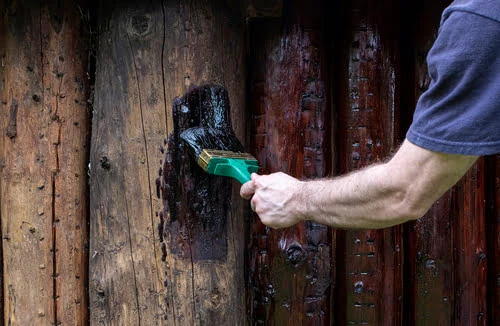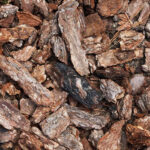A newly finished log home is a thing of beauty. To keep it looking its best long-term it needs to be stained and sealed.
Below is a breakdown of which type of stains to use, how frequently to use them, oil vs water based stain for log homes, and why you should seal your log cabin after staining it.
Table of Contents
- What Is The Best Stain To Use On A Log Home?
- What Stain Is Best For Log Cabin Floors?
- Are Oil And Water Based Stains Okay For Green Wood?
- Is Oil Or Water Based Stain Better For Interiors?
- Do Stains Waterproof Wood?
- Do You Need To Put A Finish Or Sealant Over Stain?
- Conclusion
- Related Posts
What Is The Best Stain To Use On A Log Home?
There is quite a debate raging in the log home community about the best type of stain to use for log homes, and it mostly comes down to personal preference.
Regardless of what stain you choose, it is important that the stain is specifically for log cabins. Stains designed for other wood surfaces may not allow the logs to breathe and release moisture as needed.
You should also buy as much stain as needed for the initial application, all future applications, and any necessary touch-ups.
Buying all the stains you will ever need at once ensures that the color of future applications or touch-ups will match.
To help plan for this, keep in mind that log homes need to be re-stained every 4-7 years on average. Of course, environmental factors can affect this estimate.

Pros And Cons Of Water Based Stains
Water-based stains are ideal because they dry quickly, have a minimal odor, and are easy to clean up with just warm soapy water. They are also typically more environmentally friendly and come in a wider variety of colors with options for satin or gloss finishes.
Before you jump to a water-based stain, keep in mind that they are not as durable as oil-based stains and are typically better suited as an interior stain rather than an exterior one.
Also, they are not as forgiving as oil-based stains, so if it’s your first attempt, you might want to consider sticking with oil.
Some water-based stains also come with a 5-year warranty if you apply the stain in compliance with the brand’s standards.
One last downside to water-based stains is that some do require a top coat to finish the application.
Pros And Cons Of Oil Based Stains
One of the perks of oil-based stains is that because it penetrates the wood fibers so deeply, it keeps logs from drying out too much.
This can minimize cracks between logs and checks from forming in the wood.
The downside of using oil-based stains is that they can be difficult to clean up, often requiring turpentine or mineral spirits to remove. They also take a longer time to dry than water-based and typically have a stronger odor that lasts longer.
Oil-based stains also have higher VOC (volatile organic compound) levels than water-based stains.
On the upside, oil-based stains are more durable than water-based ones and they last longer. Oil-based stains are also much more forgiving than water-based stains, so if you’re the DIY kind of person, you might want to give oil-based stains a go.

Oil vs Water Based Stain: Which Is Best?
This really comes down to personal preference. Given the durability of oil-based stains, it’s probably best to use these on the exterior of your cabin to provide added protection.
Factoring in the reduced exposure to the elements and the desire for something quick drying with a less offensive odor inside your home, you could easily use water-based stains on the interior of your cabin.
The choice is up to you as either stain will get the job done inside or out. If using a water-based stain outside though, just be sure to finish it with a clear coat.
What Stain Is Best For Log Cabin Floors?
The good news about log cabin floors is that they don’t require anything special. You can use any oil or varnish designed for hardwood floors.
It is important to put some kind of sealant, stain, oil, or varnish on your flooring though to prevent dirt, grime, and moisture from penetrating the wood.
Are Oil And Water Based Stains Okay For Green Wood?
If you are building a log cabin with green logs, you may be wondering if stains are ok for this type of wood.
Unfortunately, it is not a good idea to stain really fresh green wood. It is recommended that green wood not be stained for at least 4 months to give it some time to dry.
If and when you decide to stain green logs don’t be surprised if you see blotches, streaks, spots, and waves after the first application. Green wood doesn’t dry evenly which is what causes the blemishes.
The longer the logs have had to dry, the fewer blemishes you will have.
While you might be tempted to smooth out the blemishes by adding more coats of your stain, be aware that you will probably only make it worse. Additional staining applications can accentuate blemishes.
Either type of stain, oil or water-based can be used, but for these reasons, it’s highly recommended that you don’t stain green wood.
Is Oil Or Water Based Stain Better For Interiors?
You can use either oil or water-based stain on your log home’s interior, but you will probably prefer a water-based one. Many of the qualities that make water-based stains an attractive option overall, make them a great option for indoor use.
Water-based stains cause less odor and dry faster than oil-based. It’s also easier to clean up with warm, soapy water
Although water-based stains are less durable than oil-based ones, home interiors typically aren’t exposed to the elements like exteriors are. So you can make it easy on yourself and use a water-based one.
Water-based stains are not flammable like oil-based stains are (due to the petroleum products used) so it’s safer for use inside your home.
Finally, water-based stains come in a wide variety of colors which gives you more decor options.
Do Stains Waterproof Wood?
Stains do not waterproof wood. Both oil and water-based stains simply create a layer that goes over the wood, which then gets absorbed by the fibers. Its purpose is to protect the wood from stains, handling, dust, and debris.
Wood stains are not waterproof and do not protect against water, moisture, or scratches.

Some “stains” are acrylic and are actually stain and sealant combos. Acrylic combo stains will not only stain your log home but will also seal and waterproof the logs.
If you use regular oil or water-based stain though, you will need to seal your cabin with a finish after staining.
Do You Need To Put A Finish Or Sealant Over Stain?
Regardless of whether you use an oil or water-based stain, you will need to put a finish on your logs after staining. Using a clear finish not only repels water but also protects the wood from UV rays and discoloration as well as prevents the growth of mildew and algae.
It’s important to note that the terms “finish” and “sealant” are frequently used interchangeably in the log home community.
Finishes also come in either oil or water-based options, and the same similarities and differences apply that do for oil and water-based stains.
Polyurethane finishes are ideal for the interior of log homes as they come in a variety of looks from a high-gloss finish to a soft, gentle sheen.
It should be noted that if using a stain/sealant combo, you will need to re-stain the exterior or your log cabin every 1-2 years rather than the recommended 4-7 years if using a regular stain.
Conclusion
While you have many options for staining your log home, the ideal one is to use an oil-based stain on the exterior, a water-based one for the interior, and a quality finish on both.
Use a wood oil or finish approved for hardwood floors and you’re done. Reapply all stains every 4-7 years to keep your log cabin looking good.
You May Also Like: Considering A Log Cabin With A Copper Roof? Pros & Cons






